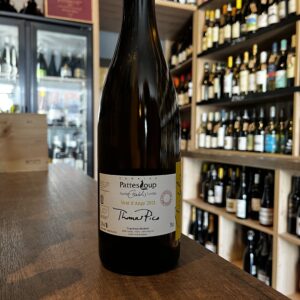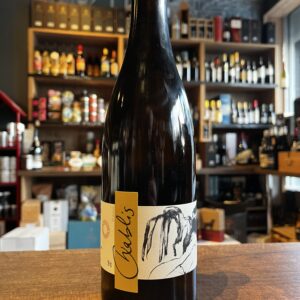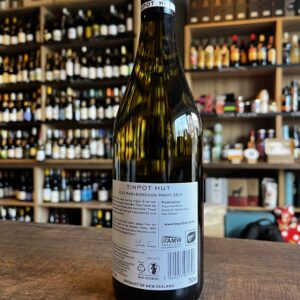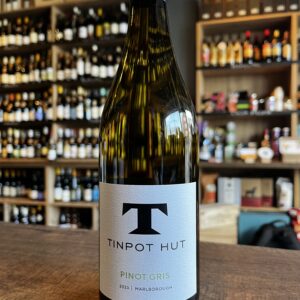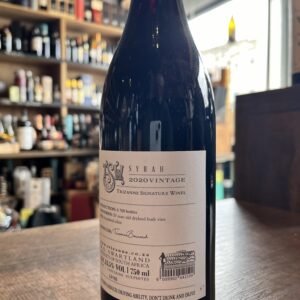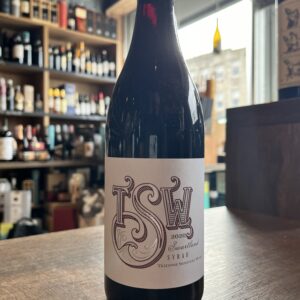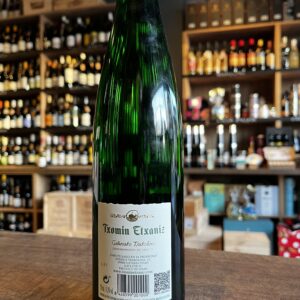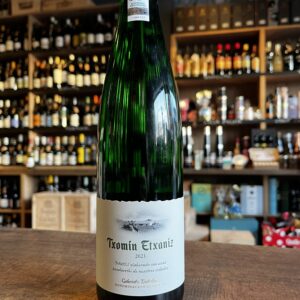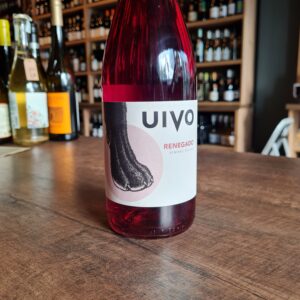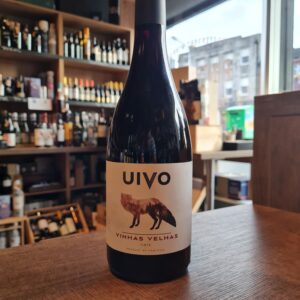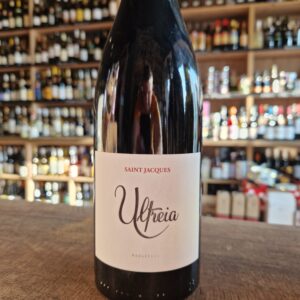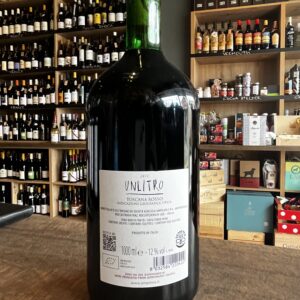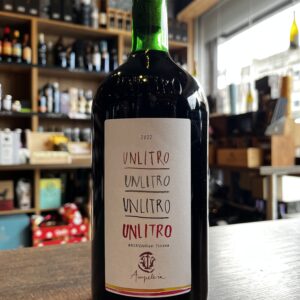-
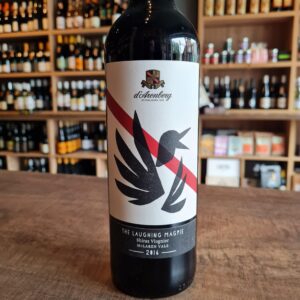 The Kookaburra is a native Australian bird famous for its distinctive laughing call, Chester's young daughters named them 'Laughing Magpies'. The Magpie plumage is black with a stripe of white feathers, representing McLaren Vale's first ever blend combining the (black) Shiraz and its white partner, Viognier. An enticing mix of primary fruit characters entwined with flowers, ginger and stone fruit. A rather dark appearance with a vivid purple hue suggesting a complex dry red. The nose is particularly intense, with peppery spice, hints of fragrant flower and perfume aromas, plus nectarines, apricots, ginger and herbs from the small parcel of viognier that the Shiraz is co-fermented with. On the palate the Shiraz is more dominant. There is some sweeter fruit characters like blackberry, blueberry and boysenberry. The palate is rich and generous and soft silky tannins. Would open 2 hours before serving and use a Decanter when possible. Enjoy this dry red wine from Australia with fillet of beef, dark meat dishes like goulash or the Asian classic Peking duck.
The Kookaburra is a native Australian bird famous for its distinctive laughing call, Chester's young daughters named them 'Laughing Magpies'. The Magpie plumage is black with a stripe of white feathers, representing McLaren Vale's first ever blend combining the (black) Shiraz and its white partner, Viognier. An enticing mix of primary fruit characters entwined with flowers, ginger and stone fruit. A rather dark appearance with a vivid purple hue suggesting a complex dry red. The nose is particularly intense, with peppery spice, hints of fragrant flower and perfume aromas, plus nectarines, apricots, ginger and herbs from the small parcel of viognier that the Shiraz is co-fermented with. On the palate the Shiraz is more dominant. There is some sweeter fruit characters like blackberry, blueberry and boysenberry. The palate is rich and generous and soft silky tannins. Would open 2 hours before serving and use a Decanter when possible. Enjoy this dry red wine from Australia with fillet of beef, dark meat dishes like goulash or the Asian classic Peking duck. -
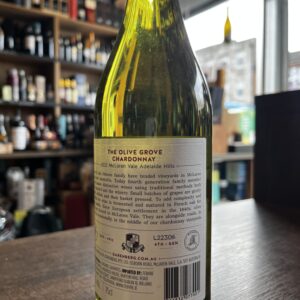
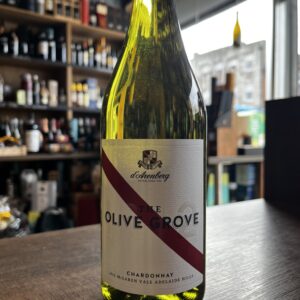 Since 1912 the Osborn family have tended vineyardsin Mclaren Vale, South of Australia. Today fourth generation family member Chester(absolutely bonkers of a guy, draws a room in and within 2 minutes has your attention), makes distintive wines using traditional methods both in the vineyards and the winery. The name comes from European settlements that arised in the 1840’s, and with them olive trees have thrived in McLaren Vale. They are alongside roads, in gardens and occasionally, block their harvesters from doing a fully mechanical job! Perfect with Antipasti, asparagus, chicken and fish
Since 1912 the Osborn family have tended vineyardsin Mclaren Vale, South of Australia. Today fourth generation family member Chester(absolutely bonkers of a guy, draws a room in and within 2 minutes has your attention), makes distintive wines using traditional methods both in the vineyards and the winery. The name comes from European settlements that arised in the 1840’s, and with them olive trees have thrived in McLaren Vale. They are alongside roads, in gardens and occasionally, block their harvesters from doing a fully mechanical job! Perfect with Antipasti, asparagus, chicken and fish -
Out of stock
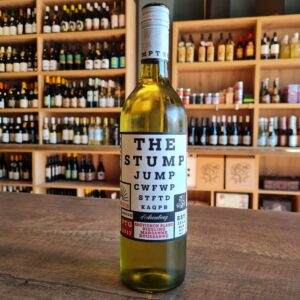 The name ‘Stump Jump’ doesn’t relate to the English game of cricket (jumping over the stumps at the end of the game), nor the breeding of livestock held in the stumps but relates to the significant South Australian invention – the Stump Jump plough. The plough soon became a worldwide implement for ploughing fields because of its ability to ride over stumps and gnarled “mallee” Eucalypt roots and snags, saving valuable time and energy by not stopping the draught horse. Every Stump Jump white of late seems to take the drinker on an interesting journey and this one is no exception. A wonderful fresh vibrant appearance with an equally appealing aroma. Notes of florals, cut grass and limes are obvious but as the wine opens up, more complex secondary notes appear such as green melon rind, passionfruit, lavender, wheat germ, and almond kernel characters. The palate is dry with a moderate level of intensity and ripe fruit characters dominated with Riesling florals and limes; the grassy sweetness and elevated acidity of the Sauvignon Blanc while the Roussanne and Marsanne add an earthy, dry stone fruit element, green almond kernels and a lovely viscous character giving textural richness to the finish. The wine has excellent balance and length of flavour which we see as being an essential element in a great value drink. The Stump Jump is at its best drinking while young, and will continue to develop in the bottle over the next three to five years. It is perfect drinking on a warm summer’s day, and a perfect match for a wide variety of light dishes.
The name ‘Stump Jump’ doesn’t relate to the English game of cricket (jumping over the stumps at the end of the game), nor the breeding of livestock held in the stumps but relates to the significant South Australian invention – the Stump Jump plough. The plough soon became a worldwide implement for ploughing fields because of its ability to ride over stumps and gnarled “mallee” Eucalypt roots and snags, saving valuable time and energy by not stopping the draught horse. Every Stump Jump white of late seems to take the drinker on an interesting journey and this one is no exception. A wonderful fresh vibrant appearance with an equally appealing aroma. Notes of florals, cut grass and limes are obvious but as the wine opens up, more complex secondary notes appear such as green melon rind, passionfruit, lavender, wheat germ, and almond kernel characters. The palate is dry with a moderate level of intensity and ripe fruit characters dominated with Riesling florals and limes; the grassy sweetness and elevated acidity of the Sauvignon Blanc while the Roussanne and Marsanne add an earthy, dry stone fruit element, green almond kernels and a lovely viscous character giving textural richness to the finish. The wine has excellent balance and length of flavour which we see as being an essential element in a great value drink. The Stump Jump is at its best drinking while young, and will continue to develop in the bottle over the next three to five years. It is perfect drinking on a warm summer’s day, and a perfect match for a wide variety of light dishes. -
Out of stock
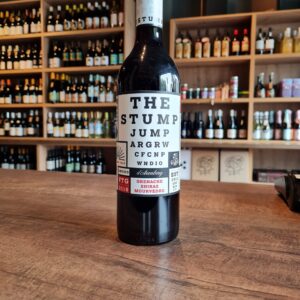 All three varieties play an important role - the Shiraz offers dark plum fruits, mulberries and licorice with plenty of concentration, depth and velvety tannin. The Grenache adds a lovely lusciousness to the wine with raspberry, blueberry and floral notes. Finally, the Mourvédre provides lovely red fruits with a hint of dried herb and importantly, a fine chalky tannin that carries all these characters to a long and wonderfully moreish finish.The fruit weight and silkyness means this wine can be enjoyed now, but it will keep developing over time. This wine screams value, recommended with hard cheeses and red meats.
All three varieties play an important role - the Shiraz offers dark plum fruits, mulberries and licorice with plenty of concentration, depth and velvety tannin. The Grenache adds a lovely lusciousness to the wine with raspberry, blueberry and floral notes. Finally, the Mourvédre provides lovely red fruits with a hint of dried herb and importantly, a fine chalky tannin that carries all these characters to a long and wonderfully moreish finish.The fruit weight and silkyness means this wine can be enjoyed now, but it will keep developing over time. This wine screams value, recommended with hard cheeses and red meats. -
Out of stock
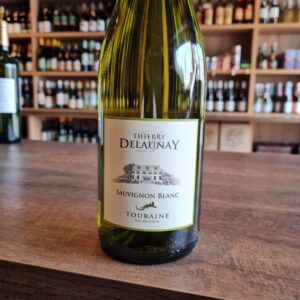 Touraine is the savvy place to look if you’re after a Sauvignon blanc which combines great value with great flavour. The Loire is Sauvignon Blanc’s homeland. So it’s no surprise that Loire native, Thierry Delaunay, is passionate about the grape. Decades of his family making wine in the region means he has the pick of the crop when it comes to choosing grapes for his wines. He looks for the best grapes from the best pockets of vines in Touraine – and the results speak for themselves. This Sauvignon is seriously refreshing, seriously citrusy, and seriously good value. You’ll find nothing finer to pair with a goat’s cheese tart. And its more restrained flavour profile makes it a perfect party wine. Santé.
Touraine is the savvy place to look if you’re after a Sauvignon blanc which combines great value with great flavour. The Loire is Sauvignon Blanc’s homeland. So it’s no surprise that Loire native, Thierry Delaunay, is passionate about the grape. Decades of his family making wine in the region means he has the pick of the crop when it comes to choosing grapes for his wines. He looks for the best grapes from the best pockets of vines in Touraine – and the results speak for themselves. This Sauvignon is seriously refreshing, seriously citrusy, and seriously good value. You’ll find nothing finer to pair with a goat’s cheese tart. And its more restrained flavour profile makes it a perfect party wine. Santé. -
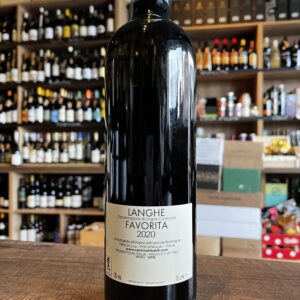
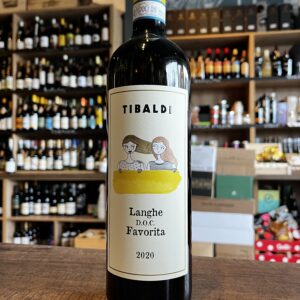 Normally I look for the inside story and drop it here. I reckon in this case its so personal that I let them tell their story... ''We are Monica and Daniela, two sisters born and raised breathing love for the winegrowing in the Roeroa colourful land, rich in biodiversity that fills us with new stimuli every day. We have inherited a passion for vines and grapes, by our father Stefano and grandfather Tunin, and so we decided to start winemaking and bet on Pocapaglia. We manage the entire wine production process: from the vineyard, where our father's help is still fundamental, to the cellar, without neglecting marketing. We both believe in commitment and tenacity, two essential ingredients to achieve the desired quality. Together we have fun, for us it is not just an occupation but it is a life choice that sees us immersed in our passion eight days a week!'' Life can be so simple and yet produce amazing and complex things... If you like Vermentino you will like this as it is its clone Pair it with someone you love
Normally I look for the inside story and drop it here. I reckon in this case its so personal that I let them tell their story... ''We are Monica and Daniela, two sisters born and raised breathing love for the winegrowing in the Roeroa colourful land, rich in biodiversity that fills us with new stimuli every day. We have inherited a passion for vines and grapes, by our father Stefano and grandfather Tunin, and so we decided to start winemaking and bet on Pocapaglia. We manage the entire wine production process: from the vineyard, where our father's help is still fundamental, to the cellar, without neglecting marketing. We both believe in commitment and tenacity, two essential ingredients to achieve the desired quality. Together we have fun, for us it is not just an occupation but it is a life choice that sees us immersed in our passion eight days a week!'' Life can be so simple and yet produce amazing and complex things... If you like Vermentino you will like this as it is its clone Pair it with someone you love -
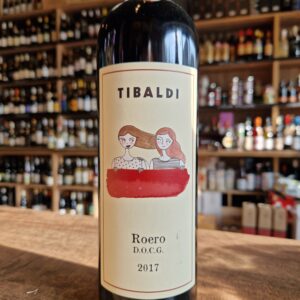 The Tibaldi family have been grape growers for several generations in the Pocapaglia area of Piemonte. In fact Nonno Tibaldi at 86 still works in the vineyard (starting with a glass from the barrel at 6am) with his son, Stefano. The Tibaldi’s have not traditionally made wine preferring to sell their crops to local producers. Stefano had 2 daughters, Monica and Daniela, and had no expectations that they would devote their lives to wine. But eldest daughter Monica studied Oenology and decided that she was going to start to make wine from the family’s wonderful fruit. Sister Daniela soon followed. And so Cantina Tibaldi was established. I simply know them as the Tibaldi Sisters. It is not unusual to see female winemakers in charge of important vineyards. Some of Australia’s finest wines are made by women and they will tell you that they are much better suited to the role as the olfactory senses are far more developed in females. What is unusual is to see the entire wine making process managed from start to finish by two women, both in their mid twenties. It can accompany any meat. Gives its best with important cheese, savory pasta and meat dishes.
The Tibaldi family have been grape growers for several generations in the Pocapaglia area of Piemonte. In fact Nonno Tibaldi at 86 still works in the vineyard (starting with a glass from the barrel at 6am) with his son, Stefano. The Tibaldi’s have not traditionally made wine preferring to sell their crops to local producers. Stefano had 2 daughters, Monica and Daniela, and had no expectations that they would devote their lives to wine. But eldest daughter Monica studied Oenology and decided that she was going to start to make wine from the family’s wonderful fruit. Sister Daniela soon followed. And so Cantina Tibaldi was established. I simply know them as the Tibaldi Sisters. It is not unusual to see female winemakers in charge of important vineyards. Some of Australia’s finest wines are made by women and they will tell you that they are much better suited to the role as the olfactory senses are far more developed in females. What is unusual is to see the entire wine making process managed from start to finish by two women, both in their mid twenties. It can accompany any meat. Gives its best with important cheese, savory pasta and meat dishes. -
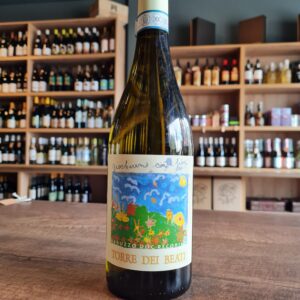 Pecorino We will play with the Flowers of Torre dei Beati born in the vineyards located on the hills at the foot of the Gran Sasso, in the heart of the Abruzzo region.It is produced exclusively with Pecorino grapes, recently recovered in Italy as an ancient grape. The Pecorino is a native vine of poor productivity and great enological interest, which is deserving the attention of the fans. Torre dei Beati uses traditional and non-intrusive winemaking techniques. After fermentation in stainless steel tanks at controlled temperature, the wine ages in steel before being bottled. It is characterized by a straw yellow color with golden reflections. The nose is fine and elegant, with hints of pear and white flowers, rounded by pleasant honeyed notes and hints of medicinal herbs. On the palate it is soft and with an excellent balance between alcohol, acidity and minerality. The wine has a long lasting and stimulating finish. Perfect to accompany aperitifs, appetizers and fish dishes, it is ideal in combination with white meats and first courses.
Pecorino We will play with the Flowers of Torre dei Beati born in the vineyards located on the hills at the foot of the Gran Sasso, in the heart of the Abruzzo region.It is produced exclusively with Pecorino grapes, recently recovered in Italy as an ancient grape. The Pecorino is a native vine of poor productivity and great enological interest, which is deserving the attention of the fans. Torre dei Beati uses traditional and non-intrusive winemaking techniques. After fermentation in stainless steel tanks at controlled temperature, the wine ages in steel before being bottled. It is characterized by a straw yellow color with golden reflections. The nose is fine and elegant, with hints of pear and white flowers, rounded by pleasant honeyed notes and hints of medicinal herbs. On the palate it is soft and with an excellent balance between alcohol, acidity and minerality. The wine has a long lasting and stimulating finish. Perfect to accompany aperitifs, appetizers and fish dishes, it is ideal in combination with white meats and first courses. -
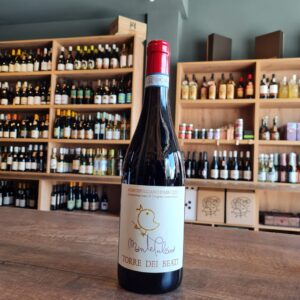 Some of you may have been lucky enough to visit Italy and have seen the amazing art and the cities and villages steeped in history. Italy is, and will always be that kind of destination where everything is out of this world. The art, the cities, the food (OMG, the food) and last but by all means not least, the wine!!! Yes of course we all have had a few Italian wines that weren't up to scratch, but generally they are hard to find unless you don't read the labels or you are really at a loss with them. As per anything Italians do, their culture and often their wine are connected to their history and the Italians take great pride in this (rightfully so). Torre dei beati is a pure example of that, as it translates as “Tower of the Blessed”, and takes its lead from a section of the large 14th century fresco adorning the church of Santa Maria in Piano at the base of the town’s hillside. The fresco features an interpretation of the Judgement Day, where a tower is the final goal for souls who have reached the after-life. And so it came to pass that the team at Torre dei Beati imagined this mythical tower to symbolise all that they aim to achieve in their efforts to create a wine typical of its locale and honestly made: though the journey may be tough and at first seemingly impossible, the end more than justified the means. The winery is owned and run by husband-and-wife team Adrianna Galasso and Fausto Albanesi. Fausto’s father-in-law, Rocco, planted the first Torre dei Beati vineyard in 1972 and handed over control in 1999 to the young couple who quickly converted the estate to organic farming in 2000, long before it became the hip thing to do. Although you can find in every Irish Restaurant Montepulciano(Grape) d'Abruzzo(The Region), most of these wines are somewhat of inferior quality due to the majority of the local winemakers focusing on quantity rather than quality. Here is quite opposite, with only the best bunches are hand-picked from the Loreto Aprutino vineyard to make this elegant Montepulciano. The wine is aged for 12 months, half in 3000l Slovenian oak casks, half in second-use French oak barriques. Showing complex fruit, lightly touched by spicy oak. Full bodied yet smooth; the finely balanced tannins work well with natural minerality and measured acidity for a lingering finish.
Some of you may have been lucky enough to visit Italy and have seen the amazing art and the cities and villages steeped in history. Italy is, and will always be that kind of destination where everything is out of this world. The art, the cities, the food (OMG, the food) and last but by all means not least, the wine!!! Yes of course we all have had a few Italian wines that weren't up to scratch, but generally they are hard to find unless you don't read the labels or you are really at a loss with them. As per anything Italians do, their culture and often their wine are connected to their history and the Italians take great pride in this (rightfully so). Torre dei beati is a pure example of that, as it translates as “Tower of the Blessed”, and takes its lead from a section of the large 14th century fresco adorning the church of Santa Maria in Piano at the base of the town’s hillside. The fresco features an interpretation of the Judgement Day, where a tower is the final goal for souls who have reached the after-life. And so it came to pass that the team at Torre dei Beati imagined this mythical tower to symbolise all that they aim to achieve in their efforts to create a wine typical of its locale and honestly made: though the journey may be tough and at first seemingly impossible, the end more than justified the means. The winery is owned and run by husband-and-wife team Adrianna Galasso and Fausto Albanesi. Fausto’s father-in-law, Rocco, planted the first Torre dei Beati vineyard in 1972 and handed over control in 1999 to the young couple who quickly converted the estate to organic farming in 2000, long before it became the hip thing to do. Although you can find in every Irish Restaurant Montepulciano(Grape) d'Abruzzo(The Region), most of these wines are somewhat of inferior quality due to the majority of the local winemakers focusing on quantity rather than quality. Here is quite opposite, with only the best bunches are hand-picked from the Loreto Aprutino vineyard to make this elegant Montepulciano. The wine is aged for 12 months, half in 3000l Slovenian oak casks, half in second-use French oak barriques. Showing complex fruit, lightly touched by spicy oak. Full bodied yet smooth; the finely balanced tannins work well with natural minerality and measured acidity for a lingering finish. -
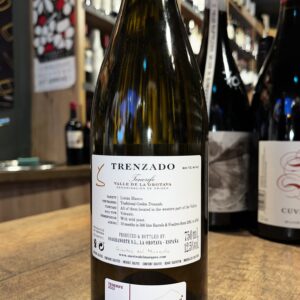
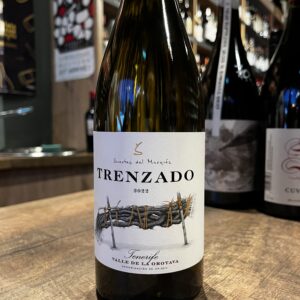 Trenzado takes its name from a local vine training method called Cordon Trenzado, in which the branches of the vine are almost braided together and supported on stakes (as pictured on the label). Tenerife has a long and fascinating winemaking history, indigenous varieties such as Listán Negro and Blanco, Tintilla and Baboso Negro. Many vineyards are made up of 100 year-old+ ungrafted vines. Jonatan Garcia runs the family winery that is located in the Orotava Valley on the north side of the island. Many are grown in a traditional trellising system called Cordon Trenzado - vine branches are braided together and supported on stakes, and eventually grow into gnarly arms sometimes several meters in length. The estate has some incredibly old, low-yielding vines and produce wines that have freshness, balance, purity of fruit, minerality and an authentic terroir character. A beautiful wine, perfect for the seasoned Chardonnay drinker, seeking to try something a different. Pair it with grilled fish dishes, shellfish and crustaceans; also well paired with stewed white meats
Trenzado takes its name from a local vine training method called Cordon Trenzado, in which the branches of the vine are almost braided together and supported on stakes (as pictured on the label). Tenerife has a long and fascinating winemaking history, indigenous varieties such as Listán Negro and Blanco, Tintilla and Baboso Negro. Many vineyards are made up of 100 year-old+ ungrafted vines. Jonatan Garcia runs the family winery that is located in the Orotava Valley on the north side of the island. Many are grown in a traditional trellising system called Cordon Trenzado - vine branches are braided together and supported on stakes, and eventually grow into gnarly arms sometimes several meters in length. The estate has some incredibly old, low-yielding vines and produce wines that have freshness, balance, purity of fruit, minerality and an authentic terroir character. A beautiful wine, perfect for the seasoned Chardonnay drinker, seeking to try something a different. Pair it with grilled fish dishes, shellfish and crustaceans; also well paired with stewed white meats -
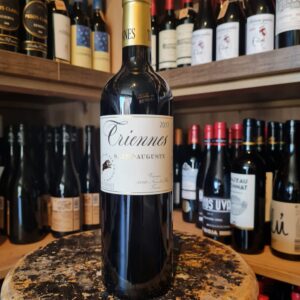 Saint Auguste is a selection of the best cuvées of Syrah, Cabernet-Sauvignon and Merlot. The robe is rich dark purple with bright ruby highlights. It offers alluring aromas of ripe black cherries, nutmeg and clove. It is full and concentrated and is a wine that can be enjoyed upon release and over the following ten to fifteen years.
Saint Auguste is a selection of the best cuvées of Syrah, Cabernet-Sauvignon and Merlot. The robe is rich dark purple with bright ruby highlights. It offers alluring aromas of ripe black cherries, nutmeg and clove. It is full and concentrated and is a wine that can be enjoyed upon release and over the following ten to fifteen years. -
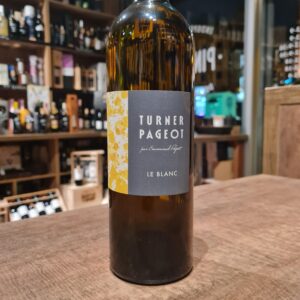 Australian scientist Karen Turner and her husband Emmanuel farm 10 hectares in the Languedoc bring you this incredible intro to orange wine! The 3 grapes here are fermented like a red wine, skins, stalks, and all-- making for white with the tannins and structure of a red. Karen’s says her goal with ‘Le Blanc’ is to bring body and freshness to the wine. The north-facing slopes where their vineyards grow on help to ensure a long and even maturation for the grapes. While Marsanne is not usually an aromatic varietal, Karen’s use of open vats brings out the heady aromas of tangerine and mango. Full-bodied and approachable, it smells like orange rinds and white flowers wilting in the sun, and tastes like yellow peaches, those tangerines and dry, dusty earth, but never loses its identity as a white wine. LADY IN CHARGE: While husband Emmanuel manages the vineyards, the real star is his wife Karen, who makes the wine and also works as the head winemaker and manager of another (very famous) Languedoc winery, Prieuré de Saint Jean de Bébian. Serious girl boss! Decant for 20 minutes before enjoying. It’ll open up and reveal its prettiness with air. Perfect for poultry, fish, cheese and early dishes. Also wonderful in itself.
Australian scientist Karen Turner and her husband Emmanuel farm 10 hectares in the Languedoc bring you this incredible intro to orange wine! The 3 grapes here are fermented like a red wine, skins, stalks, and all-- making for white with the tannins and structure of a red. Karen’s says her goal with ‘Le Blanc’ is to bring body and freshness to the wine. The north-facing slopes where their vineyards grow on help to ensure a long and even maturation for the grapes. While Marsanne is not usually an aromatic varietal, Karen’s use of open vats brings out the heady aromas of tangerine and mango. Full-bodied and approachable, it smells like orange rinds and white flowers wilting in the sun, and tastes like yellow peaches, those tangerines and dry, dusty earth, but never loses its identity as a white wine. LADY IN CHARGE: While husband Emmanuel manages the vineyards, the real star is his wife Karen, who makes the wine and also works as the head winemaker and manager of another (very famous) Languedoc winery, Prieuré de Saint Jean de Bébian. Serious girl boss! Decant for 20 minutes before enjoying. It’ll open up and reveal its prettiness with air. Perfect for poultry, fish, cheese and early dishes. Also wonderful in itself. -
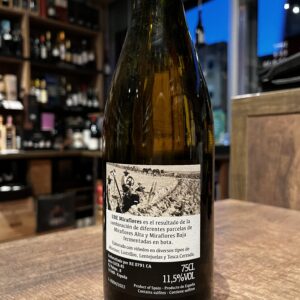
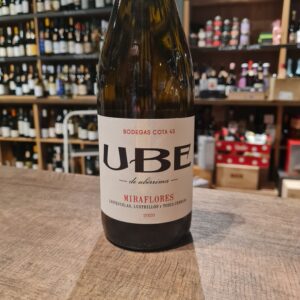 UBE Miraflores is a beautiful introduction to the terroirs of Sanlúcar de Barrameda. This winegrowing region is renowned for its chalky albariza soils and coastal setting, which impart brightness and salinity onto wines produced here. Made in a ‘sherry-like’ style, this wine ages under flor but is not fortified, with a focus on fruit character. The resulting wine is fresh and easy to drink.
UBE Miraflores is a beautiful introduction to the terroirs of Sanlúcar de Barrameda. This winegrowing region is renowned for its chalky albariza soils and coastal setting, which impart brightness and salinity onto wines produced here. Made in a ‘sherry-like’ style, this wine ages under flor but is not fortified, with a focus on fruit character. The resulting wine is fresh and easy to drink. -
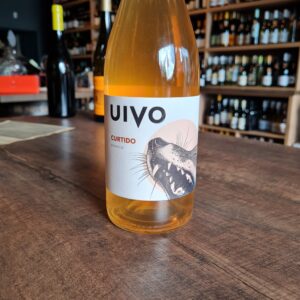 Uivo, a howl back to Nature! Naturally farmed Moscatel Galego, Branco Wine grapes with minimal intervention in the cellar, 4 months of skin contact in cement tanks. Folias de Baco was started in 2007 by young, innovative winemaker, Tiago Sampaio, who was inspired by his grandfather’s vineyard work. He has a vivacious curiosity and loves to experiment at every step of the winemaking/growing processes. He has studied agricultural engineering and has a PhD in Viticulture and Enology from Oregon State University, where he picked up on modern philosophies and aesthetics of winemaking, never forgetting his Douro roots. Folias de Baco is in the Alto Douro, in the sub-region of Cima-Corgo where the land is very tough and challenging at a higher altitude, but it is an expression of traditional melding with modern techniques. The ‘Uivo Curtido’ is comprised of 100% moscatel galego from 35+ year old vines in soils spattered with schist and granite. It is unfined and unfiltered. As tasty as it looks. Organically grown, low-intervention/natural wine, vegan. Have fun with it
Uivo, a howl back to Nature! Naturally farmed Moscatel Galego, Branco Wine grapes with minimal intervention in the cellar, 4 months of skin contact in cement tanks. Folias de Baco was started in 2007 by young, innovative winemaker, Tiago Sampaio, who was inspired by his grandfather’s vineyard work. He has a vivacious curiosity and loves to experiment at every step of the winemaking/growing processes. He has studied agricultural engineering and has a PhD in Viticulture and Enology from Oregon State University, where he picked up on modern philosophies and aesthetics of winemaking, never forgetting his Douro roots. Folias de Baco is in the Alto Douro, in the sub-region of Cima-Corgo where the land is very tough and challenging at a higher altitude, but it is an expression of traditional melding with modern techniques. The ‘Uivo Curtido’ is comprised of 100% moscatel galego from 35+ year old vines in soils spattered with schist and granite. It is unfined and unfiltered. As tasty as it looks. Organically grown, low-intervention/natural wine, vegan. Have fun with it -
 In 2003, José Ribeiro Vieira purchased a four hectare vineyard in the foothills of Serra de Aire of Cortes, in the Alta Estremadura, near Lisbon. Vale da Mata pays tribute to Vieira’s winemaker father, Manuel, who claimed that Vale de Mata was the site where he succeeded in producing his best wines. The Vale de Mata project respects the expression of its terroir, cultivating the vines sustainably and using minimal intervention in the winery. Manuel gave this wine its name and his granddaughter Catarina Viera has followed in his footsteps, continuing his winemaking legacy. In 2018. Vale da Mata is the name of a small, old vineyard located in the foothills of Serra de Aire, in Cortes. The vineyard has a maritime climate and is influenced by the Atlantic Ocean. The parcel is just a few hectares and is situated on a steep terrain with rocky soil. The land is extremely hard to work and is cultivated manually, with winter pruning and green harvesting taking place by hand. Protected to the north, it has good sunlight exposure throughout the day and is surrounded by olive trees, fig trees, walnuts and shrubs. Vale de Mata is associated with several sustainable programmes; they are a member of the FSC and grow all their grapes according to organic philosophies. The vines are trained according to the Cordon Royat method and the grapes are manually harvested at optimum maturity.
In 2003, José Ribeiro Vieira purchased a four hectare vineyard in the foothills of Serra de Aire of Cortes, in the Alta Estremadura, near Lisbon. Vale da Mata pays tribute to Vieira’s winemaker father, Manuel, who claimed that Vale de Mata was the site where he succeeded in producing his best wines. The Vale de Mata project respects the expression of its terroir, cultivating the vines sustainably and using minimal intervention in the winery. Manuel gave this wine its name and his granddaughter Catarina Viera has followed in his footsteps, continuing his winemaking legacy. In 2018. Vale da Mata is the name of a small, old vineyard located in the foothills of Serra de Aire, in Cortes. The vineyard has a maritime climate and is influenced by the Atlantic Ocean. The parcel is just a few hectares and is situated on a steep terrain with rocky soil. The land is extremely hard to work and is cultivated manually, with winter pruning and green harvesting taking place by hand. Protected to the north, it has good sunlight exposure throughout the day and is surrounded by olive trees, fig trees, walnuts and shrubs. Vale de Mata is associated with several sustainable programmes; they are a member of the FSC and grow all their grapes according to organic philosophies. The vines are trained according to the Cordon Royat method and the grapes are manually harvested at optimum maturity.


